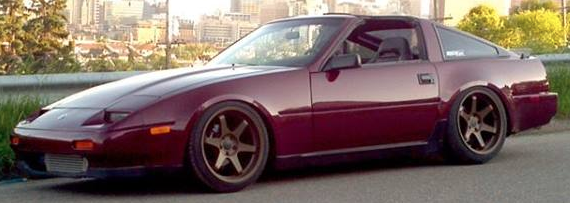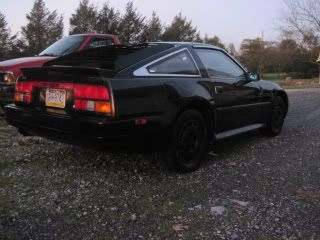Oil Catch Can and PCV Routing (and what to look for)
-
 CarelessSenior Member
CarelessSenior Member- 13279
Oil Catch Can and PCV Routing (and what to look for)
So I made my PCV catch can using a nice stainless thermos and some brass fittings. I do say it fits perfect in the stock Charcoal Canister location.
My main gripe is that I'm not sure how the Z31 engine responds to certain PCV setups.
Here is how I have mine:
1) Filter/Breather on Passenger side.
2) Original PCV hose on the driver side that has been turned toward front of car, and has a brass fitting siliconed into the outlet.
3) Line runs from brass fitting to inlet on catch can.
4) Catch can has a brass fitting on the outlet.
5) Hose runs from brass fitting to the original PCV suction tube fitting on the Compressor housing inlet elbow (black pipe that twists over the mount).
6) Ran a small vac line from the small nipple on the same elbow pipe to the left-over vent line from the Charcoal Can removal.
Now, normally I would run a closed system, and I still can. Not a big deal, but if this works… it works.
But yesterday I decided to twist open the catch can (with my steel wool wicking medium to disperse fuel from the suction line), and at the base of the can I found a thin, watery liquid that smelled somewhat like seafoam. It was not oil, but it could have had some vapours of the oil trapped within it.
I know the catch can is doing it's job, but my question is this:
1) is it moisture entering the breather filter and being purged into the catch can (which could be a good place for it, if it's collecting there rather than my oil… but could this also mean it's in the oil?) if it is moisture from the oil that was just trapped in there, I'm glad it's purged it's way to the tank and not developing a white mayonnaise like paste under my oil filler cap, which is no longer there. (BTW, RB26 oil filler caps make taking the damn thing off sooooo much easier).
2) is it sea-foam + oil vapour and moisture mix? It did smoke white for a long while but now it's all gone and it's no longer smoking white, which would indicated seafoam still in my crankcase.
3) is it fuel from having a considerable amount of misfires and having it enter the crankcase through cylinder washing?
at this point, I'm not sure what to think, but it looks like it's collecting something, and that's a start.
I think my last small bit of work I will do to the car is to purge the oil one last time and put some better oil in there, as I went from a 1 hour seafoam + quaker state wash with a fresh turbo, to a full fill on Castrol GTX, both with new filters. I have a Nissan blue filter that is brand new that I can install on my next oil change soon, and I would just like to get all the seafoam out of there.
What should my plan of action be here? Should I make it a closed loop PCV system? I was told that a check valve must be put in place along one of the lines if there is a closed loop system going from valve cover to valve cover, so that I do not pressurize my Catch can, and I have a PCV fitting that will fit the brass threaded coupler just fine, and I can use that on the inside of the can to block one flow direction or on the ouside to block the other direction, on either line too.
any help is appreciated.
below is a pic of the catch can. I think for 9 bucks (two thermos' for 9 bucks, actually), and about 8 dollars in fittings and some steel wool and hose + a paint can cap that I RTV'd to the inside base of the unit to seal up the lower fitting (yes, there is a drain fitting there as well for when the inside gets really full) it wasn't a bad deal. And I get another coffee thermos to carry around with me too. total was about 25-ish dollars =)
[attachment=0:e6bd0]_DSC3659.jpg[/attachment:e6bd0]
You'll also notice that behind the can and underneath the the lower-resting plate that it sits on, just resting on the front frame rail for the core support is the fan control relay box that houses the relay circuit to control my taurus fans too. the box is an outdoor wiring conduit junction that has a 3/4 inlet and a 90 degree 3/4 outlet that shoots straight up and under the headlight bucket, goes around the factory relay box, behind the A/C receiver dryer and PS pump, and up from the same area where the cruise control is.
I've since removed the fuses and will put a fuse BEFORE the relays, as they will be 70 amp and will handle the load, the fuse I will put in will be a 50 amp, which I will pair with my alternator and sub-box (if I decide to put that in) using a junction block with maxi fuses mounted to the side of the battery (or close to it) with double sided 3M tape that is weather proof.
that's all for now. -
 Chris86NA2TSenior Member
Chris86NA2TSenior Member- 837
im not really sure why you have a catch can for the passengers side and a breather for the drivers side.. You are still going to have that little filter get oily and nasty on you, so what have you actually acomplished by only venting one side to the can? also, how thick is the inside diameter of that hose you have feeding the catch can. my engine was completly rebuilt less than 10,000 miles ago and has less than 2% leakdown in all cylinders.. at full boost and full load a significant amount of air flows through my crankcase.. ive seen it first hand on the dyno with no catch can hooked up and just a piece of hose coming off my valve cover vents. id think that the small hose that you have isnt big enough to vent all the air fast enough to prevent pressure from building up. id use a larger diameter hose and vent both valve covers to the catch can. -
 CarelessSenior Member
CarelessSenior Member- 13279
depending on the rotation of the engine there is always one inlet and one outlet, persay.
in the case of our engines, they are on the driver side, as the engine rotates CW, and air is pulled in on the downstroke of the crank weights, and pushed out on the high side, which is on the left - passenger side.
the hoses I am using are 3/8ths. I don't know how much bigger I should go, I mean, half inch is overkill, and I am collecting something in there so some form of liquid is passing through. If it's not going to the intake tract, then I don't mind if it just sits in the head, It should really be nothing but oil, right?
I'll consider piping the driver side valve cover to the catch can, but there has to be a way to relieve the pressure.... should I install a mini filter on the can cap or with a T in one of the lines? -
 DeleriousZSenior Member
DeleriousZSenior Member- 6874
i'd make the hoses the diameter of the tube on the top of the rocker covers.

1988 300zxt. gt35, stance, etc. Wheels: Varrstoen ES2 18x9.5 et-13 225/40. 18x10.5 et0 245/40
1990 jetta vr6'd -
 CarelessSenior Member
CarelessSenior Member- 13279
to be honest, I think 3/8th's hose is well enough to flow oil a good enough pressure to fill the unit. I was just concerned about the oil/liquid i got in there. -
 Chris86NA2TSenior Member
Chris86NA2TSenior Member- 837
the rotation of the engine is irrelevant.. there is nothing that seals the left from the right.. Since the hoses are no longer hooked up to the intake there is no vacuum or pressure pulling or pushing air through the crankcase. You have to rely on the diameter of the outlets to be able to relieve the blowby pressure as quick as it is created. a proper setup would have both valve covers vented to a catch can with a drain on the bottom and a small filter on the top.Careless wrote: depending on the rotation of the engine there is always one inlet and one outlet, persay.
in the case of our engines, they are on the driver side, as the engine rotates CW, and air is pulled in on the downstroke of the crank weights, and pushed out on the high side, which is on the left - passenger side.
the hoses I am using are 3/8ths. I don't know how much bigger I should go, I mean, half inch is overkill, and I am collecting something in there so some form of liquid is passing through. If it's not going to the intake tract, then I don't mind if it just sits in the head, It should really be nothing but oil, right?
I'll consider piping the driver side valve cover to the catch can, but there has to be a way to relieve the pressure.... should I install a mini filter on the can cap or with a T in one of the lines?
I welded -10 male AN fittings to the holes in each of my valve covers. Currently i just have 90 degree fittings hanging off the valve covers, but when i actually get around to finishing it, with valve covers will have -10 (approximatly 5/8th of an inch) hose leading to the catch can. -
 DeleriousZSenior Member
DeleriousZSenior Member- 6874
what about teeing a small vacuum line with a one way filter on it into the top of the catch can or something similar? that would somewhat replicate the 'suck' of the stock system. (say that 5 times fast)

1988 300zxt. gt35, stance, etc. Wheels: Varrstoen ES2 18x9.5 et-13 225/40. 18x10.5 et0 245/40
1990 jetta vr6'd -
 SATANSenior Member
SATANSenior Member- 6782
????? :OoCareless wrote: depending on the rotation of the engine there is always one inlet and one outlet, persay.
in the case of our engines, they are on the driver side, as the engine rotates CW, and air is pulled in on the downstroke of the crank weights, and pushed out on the high side, which is on the left - passenger side.
I will be running -10 fittings on the valve cover. Stainless braided lines to a catch can, then a -10 from the catch can to the down pipe. I will then run a tube to the center of the down pipe. In theory the exhaust gasses rushing by the tube in the center of the down pipe, will create vacuum. This vacuum will go into the catch can and then into the crank case. Supposedly it is supposed to keep vacuum under the piston rings eliminating ring float. I guess I will never REALLY know how well it works if at all. This is just something I have seen on lots of high HP cars.
Like Chris said though, There is a lot of gas flowing through those lines at WOT. I kind of have a hard time believing that there will be enough vacuum made to keep up and PASS the positive crank case pressure created by blow by.85 Z31 6.0 LSX turbo 766whp/792wtq
04 GTO, LS6, big cam, porting, N20… underway for summertime daily driver. -
 85z31t88Senior Member
85z31t88Senior Member- 867
The key is to have one valve cover with a filter on it or plumbed to the intake before the turbo, and then coming off of the other valve cover to the catch tank. From the catch tank you need to have a source of vacuum. Either the pcv valve on the upper intake or the exhaust like Satan is doing.
Satan is doing it the correct way because he isnt introducing new unmetered air into the system. If you use the stock inlet tube for the drivers side valve cover and retain the maf in the stock location, it will be ideal to use the pcv valve on the upper intake for your vacuum source. The only problem with the pcv valve is that when you are in boost, the valve closes and doesnt create a vacuum for your oil catch system…
If I am wrong on anything I just wrote correct me.'85 300zx turbo: exhaust, intercooler, coilovers, etc…SOLD, will be missed
'86 300zx turbo: starting over
'97 Dodge 2500: 12v Cummins …selling and will be missed
'94 Jeep Cherokee: D60 Front 14b rear, both locked and 5.38 gears, 37" mtr's
2015 Ram 2500 megacab laramie cummins black appearance package -
 SATANSenior Member
SATANSenior Member- 6782
If there were a filter on either of the valve covers it would screw up any kind of vacuum you were trying to achieve in the crank case.85z31t88 wrote: The key is to have one valve cover with a filter on it or plumbed to the intake before the turbo, and then coming off of the other valve cover to the catch tank. From the catch tank you need to have a source of vacuum. Either the pcv valve on the upper intake or the exhaust like Satan is doing.
Satan is doing it the correct way because he isnt introducing new unmetered air into the system. If you use the stock inlet tube for the drivers side valve cover and retain the maf in the stock location, it will be ideal to use the pcv valve on the upper intake for your vacuum source. The only problem with the pcv valve is that when you are in boost, the valve closes and doesnt create a vacuum for your oil catch system…
If I am wrong on anything I just wrote correct me.85 Z31 6.0 LSX turbo 766whp/792wtq
04 GTO, LS6, big cam, porting, N20… underway for summertime daily driver. -
 CarelessSenior Member
CarelessSenior Member- 13279
well i'm going to keep the 3/8ths lines FOR NOW. i have coolant hose that I can use that is a little wider… 5/8ths and larger. I will use those later…
I was under the impression that having a filter on the inlet side of the engine (as I've read on various catch can write ups) that it will create draft that will suck in through the passenger side and be brought through the can's hoses using the vacuum from the compressor inlet, if any… but I now realize this is not at all the best way with a MAF based engine management system. good call guys, slipped my mind for a sec.
So if I run a small filter on a T with a PCV fitting that will push pressure out, but not draw air in, and cap off the inlet on the turbo-intake elbow, will this be able to push air out when pressurized but close off any incoming unmetered air?
I've just read so many ways of doing it, even using the vacuum from the exhaust to draw vacuum to burn the PCV gases in the exhaust rather than the combustion chamber (evacuation setup)… I too have seen it like that on a number of cars, but I'm using a factory exhaust and when I make my own exhaust closer to the end of the year I'll be considering a new PCV setup.
SO…
line from passenger to catch can.
line from catch can to driver side.
t-fitting with small filter and check valve on one of the lines to purge pressure but not draw unmetered air
plug on turbo inlet elbow.
does that keep the system happy? -
 CarelessSenior Member
CarelessSenior Member- 13279
see this is where I get confused because I've read a million different ways to do it. I am collecting something in the can, must be condensed air build-up in the catch can because it's colder than the air that's rushing in or something… or something… i dunno.SATAN wrote:
If there were a filter on either of the valve covers it would screw up any kind of vacuum you were trying to achieve in the crank case.
but everyone seems to have a different method.
if I get this straight, I'll draw a nice diagram. -
 CarelessSenior Member
CarelessSenior Member- 13279
I will keep this in mind. I have not checked the engine while under load (obviously can't stick my hand under the breather on the valve cover while driving…) but I may put a small barb fitting to the passenger side valve cover with my vacuum or spare shitty boost gauge… this would be a way better test to see what the engine is doing. I can run a thin vac line to the cabin and have a passenger take mental notes.SATAN wrote:
????? :Oo
I was reading on swirl and windage effects, and on some motors, it does infact create a pressure and vacuum differential on either sides of the crank case. I have no way to verify, but the websites seem to be for the popular detroit iron engines, which are V's as well, so I figured they'd be somewhat similar. They are saved on my father's computer at his house as bookmarks, perhaps I can have my brother send me the Firefox export to re-read them, but I drew some hand diagrams that mimic their setups to take with me as my printer drivers were #2'n all over the place.
I've seen and read that too, on those links. But in some cases it will suck oil at high RPM's and cause faulty O2 sensor readings if placement is incorrect, and it WILL burn oil if there is a lot of windage in the crank-case. This is the "evacuation" setup I referred to in my previous post. There are some corvettes that have tubes quite like the EGR tubes on our engines that go from the valve covers straight to either of the header banks. Of course, these are maximum effort engines, and I just don't have the skill or patience at this time to weld in some tubes like that and find the proper high-heat check valves.SATAN wrote:
I will be running -10 fittings on the valve cover. Stainless braided lines to a catch can, then a -10 from the catch can to the down pipe. I will then run a tube to the center of the down pipe. In theory the exhaust gasses rushing by the tube in the center of the down pipe, will create vacuum. This vacuum will go into the catch can and then into the crank case. Supposedly it is supposed to keep vacuum under the piston rings eliminating ring float. I guess I will never REALLY know how well it works if at all. This is just something I have seen on lots of high HP cars.
SATAN wrote:
Like Chris said though, There is a lot of gas flowing through those lines at WOT. I kind of have a hard time believing that there will be enough vacuum made to keep up and PASS the positive crank case pressure created by blow by.
does anyone see a problem with testing it this way under various loading operations?
downshift, throttle pull, light coasting, highway run in 5th gear, etc etc… ? I can afford to blow up this boost gauge as it's probably highly inaccurate for a boost pressure read-out anyway, and it would be good for the big muscle in our heads if I can get some fairly simple vacuum or pressure readings during these operating modes. -
 85z31t88Senior Member
85z31t88Senior Member- 867
[quote]SATAN wrote:What I understand from the stock setup is it draws fresh air from the intake through the drivers valve cover, then goes through the crankcase, then comes out the passengers valve cover to the pcv in the upper intake. This is drawing air through the crankcase. Adding a oil catch tank the stock pcv system would only require inserting the catch tank inbetween the passenger valve cover and the pcv valve.Originally posted by 85z31t88The key is to have one valve cover with a filter on it or plumbed to the intake before the turbo, and then coming off of the other valve cover to the catch tank. From the catch tank you need to have a source of vacuum. Either the pcv valve on the upper intake or the exhaust like Satan is doing.
Satan is doing it the correct way because he isnt introducing new unmetered air into the system. If you use the stock inlet tube for the drivers side valve cover and retain the maf in the stock location, it will be ideal to use the pcv valve on the upper intake for your vacuum source. The only problem with the pcv valve is that when you are in boost, the valve closes and doesnt create a vacuum for your oil catch system…
If I am wrong on anything I just wrote correct me.
If there were a filter on either of the valve covers it would screw up any kind of vacuum you were trying to achieve in the crank case.
If you put a filter on the drivers valve cover then it would be using unmetered air and thus would be better to use the exhaust to pull those fumes out instead of the pcv valve in the intake.'85 300zx turbo: exhaust, intercooler, coilovers, etc…SOLD, will be missed
'86 300zx turbo: starting over
'97 Dodge 2500: 12v Cummins …selling and will be missed
'94 Jeep Cherokee: D60 Front 14b rear, both locked and 5.38 gears, 37" mtr's
2015 Ram 2500 megacab laramie cummins black appearance package -
 85NA2TSenior Member
85NA2TSenior Member- 1111
Yea i plan on running some sort of catch can system as well."If your car cant do a burnout from a 60mph rolling start, then your engine needs more work."
"Nitrous doesn't blow up motors; Idiots with nitrous blow up motors."
Shooting for 500whp

